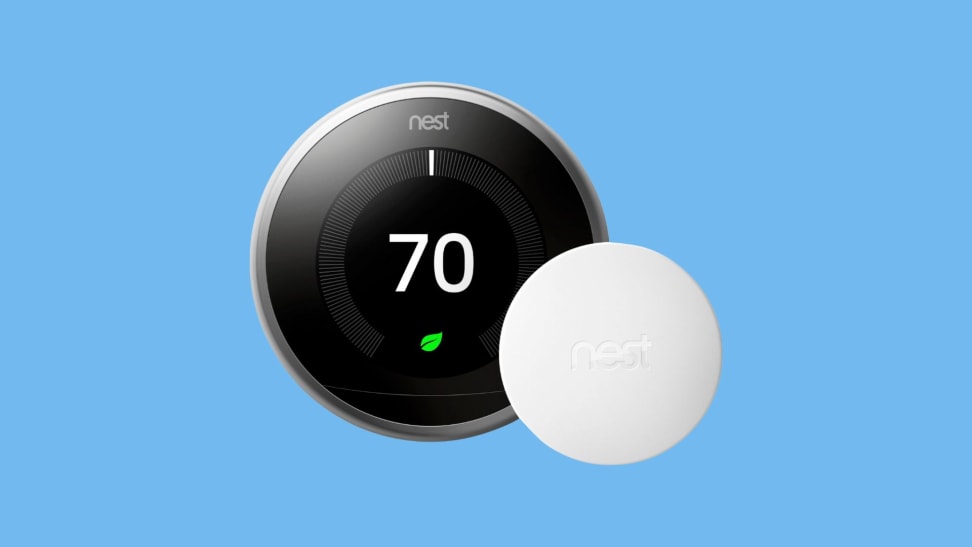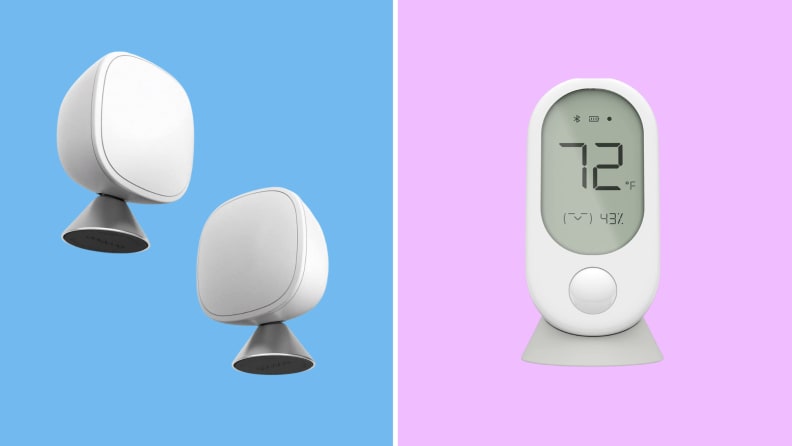Is a smart temperature sensor the key to comfort at home?
This is the secret to optimal heating and cooling
 Credit:
Google Nest / Reviewed
Credit:
Google Nest / Reviewed
Products are chosen independently by our editors. Purchases made through our links may earn us a commission.
Smart thermostats are an effective way to heat and cool your home efficiently. Like traditional thermostats, though, they only measure the temperature right at the point of installation. This can lead to hot or cold spots throughout your house, but the good news is that many Wi-Fi-enabled thermostats work with smart temperature sensors.
A smart temperature sensor provides your thermostat with a better picture of the climate throughout your home—and it goes a long way toward keeping your house the perfect temperature year-round.
Here's what you need to know about smart temperature sensors and how they work.
What is a smart temperature sensor?

The Ecobee Smart Temperature Sensor (left) and the Wyze Thermostat Smart Room Sensor (right) can monitor the climate in specific areas of your home.
A smart temperature sensor is a small device that pairs with a smart thermostat and measures for particular temperature and humidity levels in a particular area of your home. The sensor is set up and managed in the companion app and connects over Bluetooth and/or Wi-Fi. The idea is that you place a temperature sensor in an area of your home where you want to better regular the climate.
How does a smart temperature sensor work?
During the setup process, you can designate specific thresholds, like a temperature range and humidity levels, that help your sensor know when to communicate with the main thermostat.
For example, if your temperature sensor checks for humidity, you can set it to alert you when the humidity rises above 60% in the room it is in.
When the sensor detects a reading above or below the designated range, it transmits the data back to the main thermostat. The main thermostat will then do one of two things: Send a push notification to your phone alerting you of the change in climate or automatically kickstart the system for you (and stop it when your desired preference is reached).
With the first type of smart HVAC setup, it's up to you to open the companion app and make automatic adjustments to the thermostat in order to heat or cool the room to the set temperature.
The latter is only possible with a learning thermostat. Learning thermostats aren't for everyone, as some people do not like the intuitive automation that can override any manual changes you may throughout the day. However, if you want a smart thermostat setup that you can set and forget, opting for a learning thermostat that pairs with temperature sensors is the way to go.
Smart temperature sensors can also work with multi-zone HVAC systems to help heat and cool specific areas of your home to your preference.
For example, if your living room sensor detects a temperature lower than 65 degrees in the winter, the sensor can tell the thermostat responsible for heating to turn on. Or, the sensor can alert you to the change in temperature so you can make the adjustments yourself.
Temperature sensors work best in homes with multiple levels where you need to regular the temperature on the floor you're on. For example, you may place a sensor in each upstairs bedroom to make sure each room doesn't go above 72 degrees to keep the climate comfortable while your household is asleep.
Each room in your home is likely a different temperature, as some rooms have more windows and other factors that impact the indoor climate.
A temperature sensor does not, however, only heat or cool the room it is in. The whole system runs to get the room to the right temperature or humidity level, as most HVAC ducts cannot control air flow to individual rooms. Essentially, your entire home is heating or cooling to what the sensor is relaying to your main thermostat—in addition to the room it is in.
Some smart temperature sensors support schedules, so you can heat or cool a room at a certain time throughout the day to the temperature you want.
Ultimately, using a smart temperature sensor can definitely keep you more comfortable indoors.
Which smart thermostats work with smart temperature sensors?
Remote temperature sensors are available with select smart thermostats. Currently, some of the best smart thermostats, like select models from Nest, Wyze, Ecobee, Honeywell, and Cync work with temperature sensors.
A smart temperature sensor is usually a separate purchase from the thermostat itself.
The sensors are battery-powered, so you don’t need to plug them in. Most remote sensors have a battery life of several years. For example, the Nest Temperature Sensor will last up to two years before you will need to replace it (and will alert you when the battery is low).
You can either mount them to the wall, or place them on an elevated surface like a shelf. Once the sensor is paired with your smart thermostat, you don’t have to do anything else with it and can simply forget it's even there.
Each brand has its own limits on how many sensors can be connected to the thermostat at once. With the Nest Learning Thermostat (third-gen) and Cync Smart Thermostat, you can have up to six different remote sensors per thermostat, whereas Ecobee thermostats can accommodate up to 32 temperature sensors.
Select models also offer additional features to better heat and cool your home. For instance, the Nest Temperature Sensor allows you to prioritize multiple sensors, telling your thermostat that, for instance, it’s more important to maintain the temperature in your bedroom than in the dining room.
The Ecobee Smart Sensor, on the other hand, doubles as an occupancy sensor, making sure the room you’re in is always the perfect temperature.
Tips for using a smart temperature sensor

Some smart temperature sensors, like the Cync Smart Temperature Sensor, have a nail hook on the back so you can easily hang it up in a room.
Overall, remote temperature sensors are easy to use—most have a set-it-and-forget-it design—but there are a few general guidelines you’ll want to follow to make the most of your new device.
Think carefully about placement
There are several factors you’ll want to keep in mind as you select a location for your remote sensor(s). First, it’s best to stick to just one sensor per room, unless you have an extra-large space, such as an open-concept kitchen/living room.
A temperature sensor can be placed on different floors, if needed, but if your home has multiple heating zones, you’ll want to ensure the sensor is within its thermostat’s zoned rooms.
Otherwise, you may end up running up a high electricity bill, as the thermostat will keep trying to cool or heat a space that it doesn’t control.
When installing a remote sensor, select a spot where it will have good airflow. The sensor shouldn’t be tucked behind décor or covered up in any way, as this will prevent it from getting an accurate reading of the room’s temperature. Nest recommends installing sensors around chest height for best results.
Finally, you’ll want to keep the sensor away from heat sources like fireplaces, air vents, direct sunlight, and drafty windows and doors, which might skew its temperature readings.
Keep distance in mind
When selecting locations for remote temperature sensors, it’s important to keep them within range of the main thermostat. The range of your sensors may vary slightly depending on the brand, but it should be listed in the user manual.
For instance, Nest sensors should be within 50 feet of the thermostat, but the wireless range can vary depending on any walls, floors, appliances, furniture, and electronics that might block the signal. If you place a sensor too far away from the thermostat, it may not be able to send data back to the main unit.


